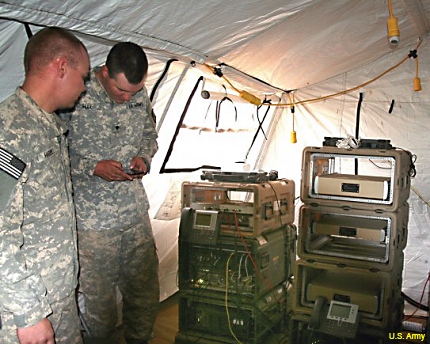The elements of a lighter, faster command post of the future
The Army is adapting commercial technologies to make its deployed communications hubs easier to ship, set up, tear down and use.

The 4G LTE/Wi-Fi system will, among other things, eliminate a lot of cables.
An Army command post is a lot like a data center—a central hub for the information, images and communications that go into military operations. And like data centers, they can be unwieldy, cluttered with all kinds of hardware, the transit cases that carried that hardware, wires, cables and more wires and cables.
For a mobile Army that is steadily pushing its command-and-control view out to individual soldiers in the field, managing a command post, which could take a platoon of soldiers a whole day to set up, could be a drag on operations. But that is changing, as new technologies and a better acquisition approach help create a lighter, faster and more efficient central hub.
The Army recently detailed how it’s increasing command post capabilities while reducing SWaP (size, weight and power) requirements, in many ways with technologies that are familiar to everyday users on the street. The future command post will be lighter to ship, more quickly set up and torn down, and more efficient to use. Here are the basic elements.
Wireless, but secure
If you want to unclutter a workspace, one of the first things to do is get rid of wires. That was easier said than done for the Army, for whom secure transmissions are paramount, until a collaborative effort produced secure 4G LTE/Wi-Fi for use in the field. The National Security Agency, Special Operations Command, Joint Staff and Nett Warrior program office worked together to develop and implement an NSA encryption system, Commercial Solutions for Classified, that’s comparable to the security software used for online shopping, the Army said. Adding what the Army only called a “special sauce” made it fit for use on military networks.
Not only does it get rid of wires, it also frees commanders and staff from their workstations, allowing them to work with classified information from smartphones and tablets without the extra baggage of encryption hardware. And by adopting commercial technologies, the Army notes, it’s making free use of billions of dollars of commercial investments.
SWaPing out
Software is lighter than hardware, and one of the key technologies the Army is using to lighten the command post load is virtualization. Virtualizing applications eliminates hardware appliances such as call managers and security and bandwidth management tools. That also cuts the number of transit cases; the Army said that the number of cases is being reduced by a third during the End Of Life Technical Refresh for the Warfighter Information Network-Tactical Increment 1`.
A microgrid power generation system called Intelligent Power also manages power use, preventing overloads through rebalancing and has cut fuel consumption by 25 to 40 percent and the number of required generators from 18 to four. The Army also has adapted the transmissions in some of its vehicles so that they could produce enough electrical power for use within a vehicle or even a small command post.
The World Wide Web
In line with the WIN-T vision of providing a common view to commanders and on-the-ground soldiers, the Army is ready to deploy the Web-based Command Post Computing Environment, or CP CE, which will eliminate the multiple workstations that had them swiveling and rolling from point to point in a chair, pulling data from one system and manually entering it into another.
CP CE provides an integrated environment designed to let commanders and soldiers use one system to share data, imagery and warfighting services ranging from logistics, intelligence and airspace management to fires and maneuvers. The system, Version 1 of which is ready for fielding, will simplify the computing backend and give users one system to start up rather than many. It also means that soldiers will only have to train on one system.
NEXT STORY: Can you trust a 3D printed jet wing?




